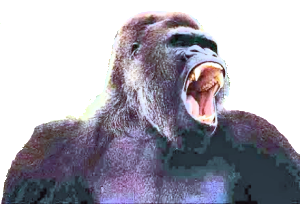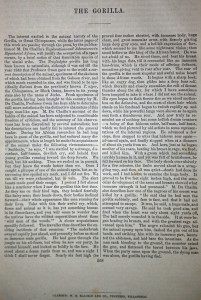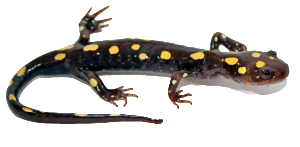In the 1860s Africa was still the dark continent. Though it’s shocking to us now to read of our ancestors stumbling around the jungle blasting at pretty much everything that moved, it’s easy to forget that these were different times with different values and priorities. Still this account of the killing of a great ape is shocking. It comes in the final page of a Herculean work of natural history compiled from submissions by the leading naturalists and explorers of the day. It is added as a single last entry, almost as if it’s a STOP PRESS late discovery. In reproducing it here we have tried to keep as close as possible to the layout and style of the original which, though in two columns, has no paragraph breaks.

The interest excited in the natural history of the Gorilla, or Great Chimpanzee, while the latter pages of this work are passing through the press, by the publication of M Du Chaillu’s Exploration and Adventures in Equatorial Africa, will justify the occupation of a spare corner, by a brief notice of that formidable species of the simial tribe. The Troglodytes gorilla has long been known to naturalists, although it was not till the year 1848 that Professor Owen gave to the world a correct description of the animal, specimens of the skeleton of which had been obtained from the Gaboon river, and which much exceeded in size, and was found to be specifically distinct from the previously known T. niger, the Chimpanzee, or Black Orang, known in its young state also by the name of Jocko. Fresh specimens of the gorilla having been brought to this country by M. Du Chaillu, professor Owen has been able to determine still more satisfactorily the distinctive characters of this huge man-like ape. M. Du Chaillu’s account of the habits of the animal has been subjected to considerable freedom of criticism, and the accuracy of his observations has been discredited by several naturalists; ·but his descriptions can hardly fail to interest the general reader. During his African researches he had long been in quest of the gorilla, and had endured many disappointments, when at length he made the acquaintance of the animal under the following circumstances: – ‘Suddenly,’ he says, ‘I was startled by a strange, discordant, half-human, devilish cry, and beheld four young gorillas running toward the deep forests. We fired, but hit nothing. Then we rushed on in pursuit, but they knew the woods better than we. Once I caught a glimpse of one of the animals again, but an intervening tree spoiled my mark, and I did not fire. We ran till we were exhausted, but in vain. The alert beasts made good their escape. I protest I felt almost like a murderer when I saw the gorillas this first time. As they ran on their hind legs, they looked fearfully like hairy men; their heads down, their bodies inclined forward their whole appearance like men running for their lives. Take with this their awful cry, which, fierce and animal as it is, has yet something human in its discordance, and you will cease to wonder that the natives have the wildest superstitions about those ‘wild men of the woods.’ A closer acquaintance speedily followed. The traveller thus describes the exciting incidents of that occasion: ‘The underbrush swayed rapidly just ahead, and presently before us stood an immense male gorilla. He had gone through the jungle on his all-fours, but when he saw our party, he erected himself, and looked us boldly in the face. He stood about a dozen yards from us, and was a sight I think I shall never forget. Nearly six feet high (he proved four inches shorter), with immense body, chest, and great muscular arms, with fiercely glaring large deep gray eyes, and a hellish expression of face, which seemed to me like some nightmare vision; thus stood before us this king of the African forest. He was not afraid of us. He stood there, and beat his breast with his huge fists, till it resounded like an immense bass-drum, which is their mode of offering defiance, meantime giving vent to roar after roar. The roar of the gorilla is the most singular and awful noise heard in these African woods. It begins with a sharp bark, like an angry dog, then glides into a deep bass roll, which literally and closely resembles the roll of distant thunder along the sky, for which I have sometimes been tempted to take it where I did not see the animal. His eyes began to flash fiercer fire as we stood motionless on the defensive, and the crest of short hair which stands on his forehead began to twitch rapidly up and down, while his powerful fangs were shown as he again sent forth a thunderous roar. And now truly he reminded me of nothing but some hellish dream creature – a being of that hideous order, half-man, half-beast, which we find pictured by old artists in some representations of the infernal regions. He advanced a few steps, then stopped to utter that hideous roar again, advanced again, and finally stopped when at a distance of about six yards from us. And here, just as he began another of his roars, beating his breast in rage, we fired, and killed him. With a groan which had something terribly human in it, and yet was full of brutishness, he fell forward on his face. The body shook convulsively for a few minutes, the limbs moved about in a struggling way, and then all was quiet-death had done its work, and I had leisure to examine the huge body. It proved to be five feet eight inches high, and the muscular development of the arms and breasts showed what immense strength it had possessed.’ M. Du Chaillu also describes how one of the negroes of his escort was killed by a gorilla: ‘He said that he had met the gorilla suddenly, and face to face, and that it had not attempted to escape. It was, he said, a huge male, and seemed very savage. He said he took good aim, and fired when the beast was only about eight yards off. The ball merely wounded it in the side. It at once began beating its breasts, and with the greatest rage advanced upon him.’ The negro reloaded his gun, but the animal sprang upon him, dashed the gun out of his hands, and striking him with its immense paw, lacerated the abdomen, and laid bare the intestines. As the man sank bleeding to the ground, the monster seized the gun, and flattened the barrel between his jaws. When the party came upon the ground, the dying man was alone, the gorilla having fled.


